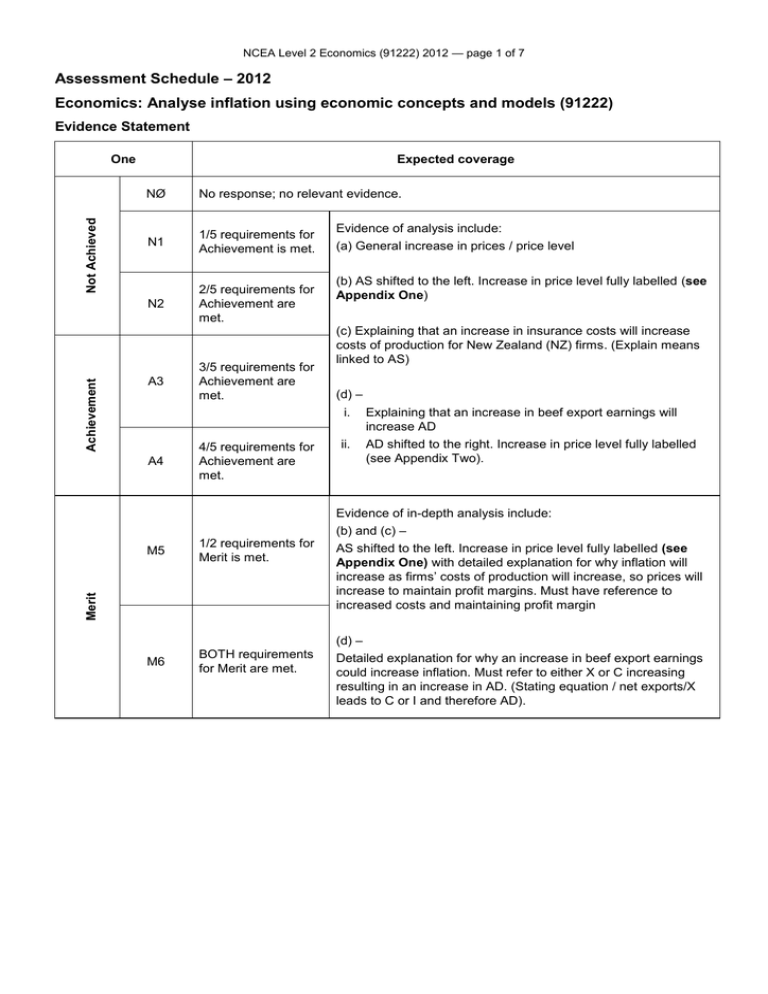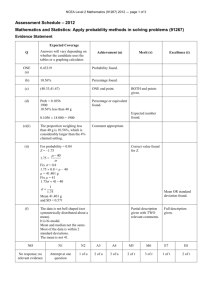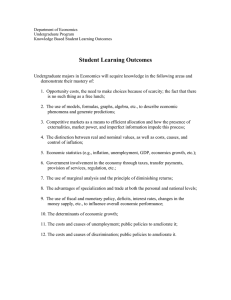(111KB)
advertisement

NCEA Level 2 Economics (91222) 2012 — page 1 of 7 Assessment Schedule – 2012 Economics: Analyse inflation using economic concepts and models (91222) Evidence Statement Achievement Not Achieved One Expected coverage NØ No response; no relevant evidence. N1 1/5 requirements for Achievement is met. N2 2/5 requirements for Achievement are met. A3 A4 3/5 requirements for Achievement are met. 4/5 requirements for Achievement are met. Evidence of analysis include: (a) General increase in prices / price level (b) AS shifted to the left. Increase in price level fully labelled (see Appendix One) (c) Explaining that an increase in insurance costs will increase costs of production for New Zealand (NZ) firms. (Explain means linked to AS) (d) – i. Explaining that an increase in beef export earnings will increase AD ii. AD shifted to the right. Increase in price level fully labelled (see Appendix Two). Evidence of in-depth analysis include: (b) and (c) – M6 BOTH requirements for Merit are met. Merit M5 1/2 requirements for Merit is met. AS shifted to the left. Increase in price level fully labelled (see Appendix One) with detailed explanation for why inflation will increase as firms’ costs of production will increase, so prices will increase to maintain profit margins. Must have reference to increased costs and maintaining profit margin (d) – Detailed explanation for why an increase in beef export earnings could increase inflation. Must refer to either X or C increasing resulting in an increase in AD. (Stating equation / net exports/X leads to C or I and therefore AD). NCEA Level 2 Economics (91222) 2012 — page 2 of 7 Evidence of comprehensive analysis include: E7 Compares and contrasts with a valid reason: d(i) (d) – Comparing and contrasting the impact on inflation of an increase in beef export earnings with an increase in insurance costs for NZ firms. Excellence Must give a detailed explanation for why an increase in insurance costs could increase inflation by more than an increase in beef export earnings. The detailed explanation must include: E8 Compares and contrasts with a valid reason PLUS the use of the AS/AD model in the explanation: (d) (i) AND (d) (ii). i. ii. a valid reason for AS decreasing by more than AD increasing (eg as the increase in insurance costs would affect all NZ industries whereas the increase in export earnings is only affecting the beef industry) showing a decrease in AS on Graph Two which is larger than an increase in AD. Larger change in the price level for the AS shift is also shown. (See Appendix Two.) NCEA Level 2 Economics (91222) 2012 — page 3 of 7 Not Achieved Two Expected coverage NØ No response; no relevant evidence. N1 1/6 requirements for Achievement is met. N2 2/6 requirements for Achievement are met. A3 3/6 requirements for Achievement are met including ONE of (b) or (c). Evidence of analysis include: (a) – (i) M – Money supply (ii) V – Velocity of circulation (iii) P – Price level (iv) Q – Real output. (Real GDP / Quantity of Transactions / Quantity of Goods and Services, NOT Quantity). Achievement (b) – A4 4/6 requirements for Achievement are met including BOTH of (b) and (c). Explaining that an increase in the money supply will increase the price level, by referring to the quantity theory of money equation. (c) – Explaining how a reduction in consumer confidence will decrease the velocity of circulation, eg consumer spending declines, so money is being spent at a lower rate. Evidence of in-depth analysis include: (b) – M6 BOTH requirements for Merit are met. Merit M5 1/2 requirements for Merit is met. Detailed explanation for why an increase in the money supply will increase the price level by the same proportion / percentage assuming V and Q are constant. (c) – Detailed reason for why a reduction in consumer confidence will reduce the velocity of circulation and consequently the price level NCEA Level 2 Economics (91222) 2012 — page 4 of 7 Evidence of comprehensive analysis include: (c) – E7 Compares and contrasts with a valid reason: (c) (i) Comparing and contrasting the effect on the price level of an increase in the money supply with an increase in the money supply accompanied by a reduction in consumer confidence. The detailed explanation must include: Excellence (i) a valid reason for why an increase in the money supply accompanied by a reduction in consumer confidence will lead to a smaller increase/decrease/no change in the price level Eg, as V will decline, so P will only increase if the M increases by more than the decrease in V. Whereas for an increase in the money supply only, we are assuming V is constant, so the price level will increase by the same amount as the increase in the money supply E8 Compares and contrasts with a valid reason AND refers to percentage or proportion in the explanation: (c) (ii) (ii) a valid reason for why an increase in the money supply accompanied by a reduction in consumer confidence will lead to a smaller increase / decrease / no change in the price level AND refers to percentage/proportion in the explanation. Eg, as V will decline, so P will only increase if the percentage increase in M is higher than the percentage decrease in V. Whereas for an increase in the money supply only, we are assuming V is constant, so the price level will increase by the same percentage as the increase in the money supply. NCEA Level 2 Economics (91222) 2012 — page 5 of 7 Achievement Not Achieved Three Expected coverage NØ No response; no relevant evidence. N1 1/7 requirements for Achievement is met. N2 2/7 requirements for Achievement are met. (i) Explanation of why households may benefit eg lower cost of living. More to spend on other goods and services (ii) Explanation of why businesses may benefit eg lower costs of production due to cheaper internet. 3/7 requirements for Achievement are met. (c) – Evidence of analysis include: (a) Explanation of deflation AND disinflation – eg, deflation is a decrease in the general level of prices, and disinflation is a fall in the inflation rate (b) – A3 A4 5/7 requirements for Achievement are met. (i) Explanation of why the large business could be better off, eg exports will be more price-competitive, less chance of labour costs increasing (ii) Explanation of why the small business could be worse off, eg imports will be less price competitive (iii) Explanation of why the property owner could be worse off, eg potential capital gain reduced, real value of mortgage is declining by less (iv) Explanation of why the householder could be better off, eg the real value / purchasing power of their income / savings is declining by less. Evidence of in-depth analysis include: (a) – M5 TWO of (a), (b), (c) (i), (c) (ii). Detailed explanation for why inflation will decline as these goods represent a significant part of a typical household budget. However for deflation to occur there must be a decrease in the general level of prices, not just a decrease for some items. (b) – Merit Detailed explanation for why households and firms could benefit. Must include a valid link between the two groups – eg, businesses may have increased sales/revenue/profits due to increased spending by households, or there may be more jobs for households as firms are selling more and their costs of other inputs are lower. (c) – M6 (i) Detailed explanation which includes ONE valid reason for why the large business could be better off OR why the small business could be worse off – eg. The large business will be better off because their product will be more competitive as it is becoming relatively more affordable for overseas buyers (ii) Detailed explanation which includes ONE valid reason for why the property owner could be worse off OR why the householder could be better off – eg, The householder on a fixed income will be better off because even though nominal income has not changed the real value of their income will not be falling as quickly. THREE of (a), (b), (c) (i), (c) (ii). NCEA Level 2 Economics (91222) 2012 — page 6 of 7 Evidence of comprehensive analysis include: Excellence (c) – E7 E8 ONE of (c) (i) or (c) (ii). Comparing and contrasting the impact of a reduction in inflation on various groups by: (i) Explaining in detail why the large business will be better off compared with the small business which will be worse off. (ii) Explaining in detail why the property owner will be worse off compared with the householder who will be better off. BOTH of (c) (i) and c (ii). Appendix One – Question One (b) NCEA Level 2 Economics (91222) 2012 — page 7 of 7 Appendix Two – Question One (d) Judgement Statement Score range Not Achieved Achievement Achievement with Merit Achievement with Excellence 0–6 7 – 12 13 – 18 19 – 24

